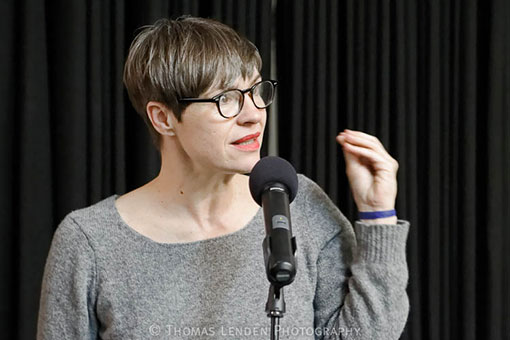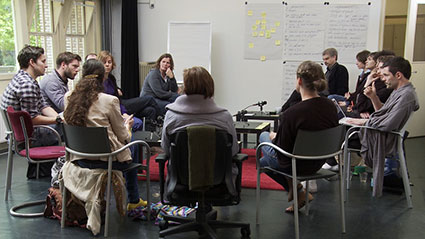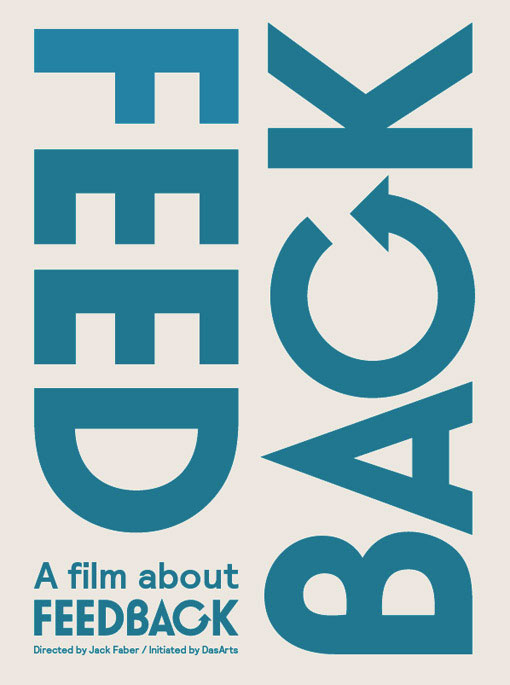For the last two years, the master’s programme has been a laboratory in which DasArts has experimented with different feedback formats. Philosopher Karim Benammar and performance artist Siegmar Zacharias were invited to give workshops. Benammar introduced two new elements to feedback: a diversity of formats and a clear structure. “We threw ourselves in at the deep end,” explains Van Lindt. “By trying things out, and evaluating them with the students and Benammar, we devised a method that works – especially within collective feedback settings.”
Previously, there were hardly moderated discussions in which feedback could be given. They were often messy and unstructured. “Someone would shout out something about the concept, and someone else about the lighting. Another person would comment about the acting style. A situation had arisen in which the maker would respond defensively, and there was a fear of feedback,” says Van Lindt. A culture like that is hardly conducive to the development of the maker, and out of place in a training organisation like DasArts, where the exchange of ideas between students plays a central role.
Questions on the table
One of the most important changes introduced by Benammar is that the person receiving feedback is also partly responsible for deciding what it should be about. Before the session even begins, he determines what it is that he wishes to receive comments on. Say Van Lindt: “We’re working towards a culture in which the person who presents his work also dares to lay his questions upon the table. Instead of placing a shield in front of his work, and himself, the presenter invites his colleagues to react. If there are things that you’re still grappling with, and your material reveals it, the session can be especially informative and productive.”
Van Lindt singles out one of the most striking aspects of the method: the person presenting their work barely speaks to the person giving feedback. There are a few moments when the maker is briefly engaged, but the focus is on reception. “The presenters get the last word and, in this, they often let you know they are grateful. They roll up their sheets and take them home. They really feel that they have been given something that will help them to develop their work further. There’s no overwhelming jumble of superficial judgments breaking over them like a tsunami.” Another interesting element that Van Lindt touches upon is that the fact that the sessions are often determined by a time factor; some formats, for example, take just five minutes. She describes it as a constraint that activates, because participants are forced to formulate precisely. “Sometimes you think: ‘wow, that’s interesting’, and then you have to stop. Of course, that’s frustrating, but then I point out the corridors of our building, and the oceans of time that you have after the feedback session, in which to continue the discussion.”
As often with the introduction of new formats and changes, there was also some resistance amongst the students in 2011. The first obstacle was that the formats came from a world that was not the art world. Benammar is a philosopher, but he also works for companies and managers from the commercial sector. According to Van Lindt, many artists have a healthy and unhealthy resistance to this. Another point was the idea of freedom versus structure. A much-heard comment was: ‘why can’t I just say what I think?!’ Students saw this as a limitation on the conceptual level. “But it wasn’t long before all the possibilities of the model became clear and the benefits obvious. Meanwhile, we’ve become so experienced that we can play with the formats and adjust them according to the stage that the work is at. It’s therefore a rigid system but, at the same time, not,” reflects Van Lindt.
The DVD, the workshop
Very early on, when the teachers and students were still struggling with the formats, there was a realisation that an urge for a new culture of feedback also existed amongst our colleagues in the cultural world, and in the education sector. Requests to attend the sessions gradually increased. This was occasionally allowed, but couldn’t happen all the time. The growing interest in the method was reason for making a DVD. Recordings of feedback sessions interspersed with an introduction by Benammar, performance clips, and short interviews with advisors, students and staff, present a clear picture of the method that is currently applied at DasArts.
Van Lindt: “The DVD is now mainly distributed in Belgium, Germany and the Netherlands and, mainly because of this, we’ve already received a large number of requests to introduce the method. For example, we gave a workshop in Brussels during the Working Title Platform organised by Workspace Brussels. This festival focuses on showing and discussing ‘work in progress’. We gave an introduction and led feedback sessions for each presentation. The development of the method has been a labour of love that we’d like to share. We now also train our students to moderate the sessions and to learn the method. Recently, a former student lead a number of feedback sessions in Switzerland, where master students of different schools presented work to each other. We are, of course, primarily a master’s course, so each individual inquiry to attend a feedback workshop is carefully considered.”
Incredibly powerful
The DVD can also be used, according to Van Lindt, as a tool by anyone who wishes to organise feedback sessions, although it isn’t a proper instruction film: “you have to be prepared to just throw yourself into the deep and to learn as you go along,” she adds. “For us, the development of this method was imperative if we were to realise our training goals. It was a very educational process and one that was worth investing a lot of time in – absolutely. There are so many development opportunities. We’ve just completed a number of feedback sessions and they were incredibly powerful.”
If you would like to receive a DVD, please go to the webpage:
- a film about feedback



